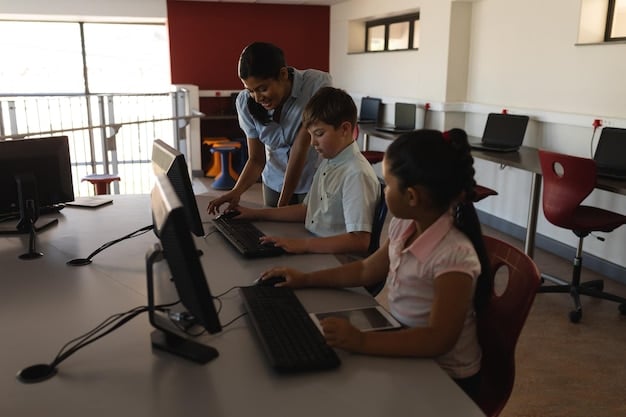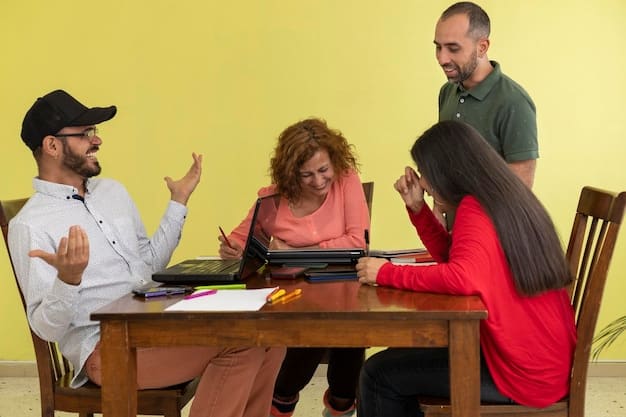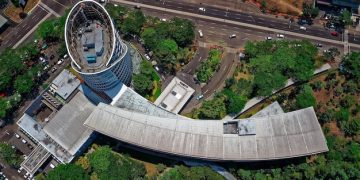How Peru’s Education Transformation Shapes Future US Workforce Skills

Peru’s ongoing education reforms are poised to significantly impact the skills of its future workforce, influencing the talent pool available to US employers seeking to expand or outsource operations to the country.
The educational landscape in Peru is undergoing a significant transformation. Understanding how Peru’s education reforms impact the skills of the future workforce for US employers is crucial for businesses looking to tap into the nation’s growing potential.
Peru’s Education System: An Overview
Peru’s education system has traditionally faced challenges, including inequality, limited access, and outdated curricula. However, recent reforms aim to address these issues and prepare students for the demands of the 21st-century workforce. This section provides an overview of the current state of education in Peru and the key challenges the reforms seek to overcome.
Key Challenges in Peruvian Education
Despite progress, Peru’s education system still grapples with several challenges. Addressing these issues is vital for creating a skilled workforce that can compete in the global economy.
- Inequality in Access: Disparities exist between urban and rural areas, as well as among different socioeconomic groups.
- Quality of Teaching: Many teachers lack adequate training and resources, impacting the quality of instruction.
- Outdated Curriculum: The curriculum often fails to align with the needs of the modern job market, leaving graduates unprepared for specific roles.
- Infrastructure Deficiencies: Many schools, particularly in rural areas, lack basic infrastructure and resources.
Addressing these challenges is crucial for unlocking the full potential of Peru’s workforce and ensuring that US employers can benefit from a highly skilled talent pool.

The Goals of Peru’s Education Reforms
The education reforms in Peru are designed to modernize the system and equip students with the skills necessary for future success. Understanding these goals is essential for gauging the potential impact on the workforce.
These reforms focus on several key areas, including curriculum modernization, teacher training, and increased investment in technology and infrastructure. The overarching goal is to create a more equitable, relevant, and effective education system that prepares students for the jobs of tomorrow.
Curriculum Modernization
The reform aims to make the curriculum more relevant to the needs of the modern workforce and align it with international standards. This includes incorporating more STEM subjects, critical thinking skills, and practical applications in the curriculum.
- Focus on STEM Subjects: Emphasizing science, technology, engineering, and mathematics to create a workforce ready for technological advancements.
- Development of Critical Thinking: Fostering analytical and problem-solving skills to excel in complex work environments.
- Practical Applications: Integrating real-world experiences and project-based learning to develop hands-on expertise.
By modernizing the curriculum, Peru aims to create a workforce that is more adaptable, innovative, and competitive in the global market. This will directly impact the skills that US employers can expect from Peruvian workers.
Impact on Key Skills Sought by US Employers
The reforms are set to enhance specific skill sets that are highly valued by US employers. Understanding these improvements is crucial for recognizing the potential benefits of hiring from Peru.
US employers often seek candidates with strong technical skills, problem-solving abilities, and communication proficiency. Peru’s education reforms are specifically targeting these areas, potentially creating a workforce that aligns more closely with the needs of American businesses.
Enhanced Technical Skills
The focus on STEM education will lead to a workforce with stronger technical skills, making Peruvian professionals more attractive to US employers in sectors such as IT, engineering, and manufacturing.
By emphasizing science, technology, engineering, and mathematics, Peru aims to produce graduates who are proficient in using advanced tools and technologies. This will enable them to contribute effectively to projects requiring technical expertise.
Problem-Solving and Analytical Abilities
The emphasis on critical thinking and problem-solving will result in a workforce capable of tackling complex challenges and finding innovative solutions, which are highly valued by US employers across various industries.
The reforms aim to foster analytical abilities by encouraging students to think critically, evaluate information, and develop creative solutions to problems. This will lead to a workforce that is more adaptable and resilient in the face of uncertainty.
Challenges and Obstacles to Reform Implementation
Despite the ambitious goals, the implementation of these reforms faces significant challenges. Recognizing these obstacles is crucial for a realistic assessment of the reforms’ potential impact.
Successfully implementing these reforms requires overcoming hurdles like funding constraints, teacher training limitations, and resistance to change from traditional educational institutions. These challenges could affect the speed and extent of the reforms’ impact on the workforce.

Funding Constraints
Limited financial resources can hinder the implementation of reforms, especially in areas that require significant investment in infrastructure, technology, and teacher training.
Insufficient funding can slow down the modernization of educational facilities, the acquisition of necessary resources, and the implementation of new programs. Overcoming these financial constraints is crucial for realizing the full potential of the reforms.
Teacher Training Limitations
Many teachers need additional training to effectively implement the new curriculum. Addressing this limitation is essential to ensuring that students receive quality instruction aligned with the reforms’ goals.
Effective implementation of the reforms depends on teachers’ ability to adapt to new teaching methodologies and incorporate them into their classrooms. Providing adequate training and support to teachers is critical for the success of the reforms.
The Role of Technology in Peruvian Education Reforms
Technology plays a pivotal role in the modernization of Peru’s education system. Understanding how technology is being integrated is crucial for evaluating the reforms’ impact.
The integration of technology in Peruvian education is aimed at improving access, enhancing instruction, and preparing students for a digital world. This includes providing access to computers, internet connectivity, and digital learning platforms.
- Access to Computers: Increasing the availability of computers and other devices in schools to facilitate digital learning.
- Internet Connectivity: Expanding internet access in schools to enable students to connect with online resources.
- Digital Learning Platforms: Implementing digital learning platforms that provide access to educational content and collaborative tools.
By leveraging technology, Peru seeks to bridge the educational gap and create a more equitable and effective learning environment. This will help produce a workforce that is technologically literate and capable of thriving in the digital economy.
Long-Term Implications for US Employers
In the long term, the success of Peru’s education reforms will have profound implications for US employers. Understanding these potential benefits is crucial for strategic workforce planning.
A more skilled and educated workforce in Peru can provide US employers with a larger pool of qualified candidates for outsourcing, nearshoring, and direct hiring. This can lead to cost savings, increased efficiency, and access to specialized expertise.
Increased Availability of Skilled Workers
The reforms are expected to increase the supply of skilled workers in Peru, making it an attractive location for US companies looking to expand their operations.
A more educated and skilled workforce will enhance Peru’s competitiveness as a hub for outsourcing and nearshoring, providing US employers with access to a larger talent pool.
Better Prepared Workforce
The reforms will result in a workforce that is better prepared to meet the demands of the modern job market, offering US employers access to a more adaptable and innovative talent pool.
Graduates with enhanced technical skills, problem-solving abilities, and communication competence will contribute to a more productive and efficient workforce. This will reduce training costs and time for US employers.
| Key Point | Brief Description |
|---|---|
| 🎓 Curriculum Modernization | Focuses on relevance to modern jobs and international standards. |
| 💻 Tech Integration | Aims to boost access, improve instruction, and aid digital readiness. |
| 📈 Employer Benefits | Offers a larger pool of skilled candidates for US businesses. |
| 📚 Teacher Training | Ongoing efforts to upgrade teachers’ abilities and methods for reform goals. |
Frequently Asked Questions
▼
The primary goals involve modernizing the education system, enhancing skills relevant to contemporary job markets, and reducing educational inequalities across Peru.
▼
By cultivating a better-prepared workforce, US employers gain access to skilled candidates, fostering more effective outsourcing, nearshoring, and direct hiring opportunities.
▼
Key priorities include STEM subjects, digital literacy, critical thinking, and communication skills, all vital for success in today’s global workforce.
▼
Challenges include limited funding, inadequate teacher training, infrastructure deficits, and resistance to adopting new teaching methodologies in some regions.
▼
Technology boosts access to learning, enhances instructional methods, and prepares students for the digital era by equipping them with tools like computers and digital platforms.
Conclusion
Peru’s education reforms represent a concerted effort to build a workforce prepared to compete in the global economy. As these reforms take root, US employers stand to benefit from a more skilled, adaptable, and technologically proficient talent pool. Monitoring the progress and outcomes of these initiatives will be crucial for businesses seeking to tap into the potential of the Peruvian workforce.





